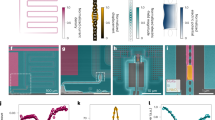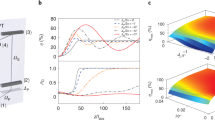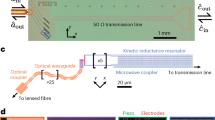Abstract
Photons with optical frequencies of a few hundred terahertz are perhaps the only way to distribute quantum information over long distances. Superconducting qubits, which are one of the most promising approaches for realizing large-scale quantum machines, operate on microwave photons at frequencies that are ~40,000 times lower. To network these quantum machines across appreciable distances, we must bridge this frequency gap. Here we implement and demonstrate a transducer that can generate correlated optical and microwave photons. We use it to show that by detecting an optical photon we generate an added microwave photon with an efficiency of ~35%. Our device uses a gigahertz nanomechanical resonance as an intermediary, which efficiently couples to optical and microwave channels through strong optomechanical and piezoelectric interactions. We show continuous operation of the transducer with 5% frequency conversion efficiency, input-referred added noise of ~100, and pulsed microwave photon generation at a heralding rate of 15 Hz. Optical absorption in the device generates thermal noise of less than two microwave photons. Improvements of the system efficiencies and device performance are necessary to realize a high rate of entanglement generation between distant microwave-frequency quantum nodes, but these enhancements are within reach.
This is a preview of subscription content, access via your institution
Access options
Access Nature and 54 other Nature Portfolio journals
Get Nature+, our best-value online-access subscription
$29.99 / 30 days
cancel any time
Subscribe to this journal
Receive 12 print issues and online access
$209.00 per year
only $17.42 per issue
Buy this article
- Purchase on Springer Link
- Instant access to full article PDF
Prices may be subject to local taxes which are calculated during checkout



Similar content being viewed by others
Data availability
The data for Figs. 2 and 3 and Extended Data Figs. 1, 2, 3 and 5 are available on Zenodo at https://doi.org/10.5281/zenodo.7903643. Additional data that support the findings of this study are available from the corresponding author upon reasonable request. Source data are provided with this paper.
References
Altman, E. et al. Quantum simulators: architectures and opportunities. PRX Quantum 2, 017003 (2021).
Alexeev, Y. et al. Quantum computer systems for scientific discovery. PRX Quantum 2, 017001 (2021).
Awschalom, D. et al. Development of quantum interconnects (quics) for next-generation information technologies. PRX Quantum 2, 017002 (2021).
Arute, F. et al. Quantum supremacy using a programmable superconducting processor. Nature 574, 505–510 (2019).
Wu, Y. et al. Strong quantum computational advantage using a superconducting quantum processor. Phys. Rev. Lett. 127, 180501 (2021).
Jurcevic, P. et al. Demonstration of quantum volume 64 on a superconducting quantum computing system. Quantum Sci. Technol. 6, 025020 (2021).
Pompili, M. et al. Realization of a multinode quantum network of remote solid-state qubits. Science 372, 259–264 (2021).
Daiss, S. et al. A quantum-logic gate between distant quantum-network modules. Science 371, 614–617 (2021).
Ofek, N. et al. Extending the lifetime of a quantum bit with error correction in superconducting circuits. Nature 536, 441–445 (2016).
Krinner, S. et al. Realizing repeated quantum error correction in a distance-three surface code. Nature 605, 669–674 (2022).
Serafini, A., Mancini, S. & Bose, S. Distributed quantum computation via optical fibers. Phys. Rev. Lett. 96, 010503 (2006).
Gottesman, D., Jennewein, T. & Croke, S. Longer-baseline telescopes using quantum repeaters. Phys. Rev. Lett. 109, 070503 (2012).
Brady, A. J. et al. Entangled sensor-networks for dark-matter searches. PRX Quantum 3, 030333 (2022).
Shor, P. W. & Preskill, J. Simple proof of security of the BB84 quantum key distribution protocol. Phys. Rev. Lett. 85, 441–444 (2000).
Han, X., Fu, W., Zou, C.-L., Jiang, L. & Tang, H. X. Microwave-optical quantum frequency conversion. Optica 8, 1050–1064 (2021).
Aspelmeyer, M., Kippenberg, T. J. & Marquardt, F. Cavity optomechanics. Rev. Mod. Phys. 86, 1391–1452 (2014).
Teufel, J. D. et al. Circuit cavity electromechanics in the strong-coupling regime. Nature 471, 204–208 (2011).
Andrews, R. W. et al. Bidirectional and efficient conversion between microwave and optical light. Nat. Phys. 10, 321–326 (2014).
O’Connell, A. D. et al. Quantum ground state and single-phonon control of a mechanical resonator. Nature 464, 697–703 (2010).
Bochmann, J., Vainsencher, A., Awschalom, D. D. & Cleland, A. N. Nanomechanical coupling between microwave and optical photons. Nat. Phys. 9, 712–716 (2013).
Zeuthen, E., Schliesser, A., Sørensen, A. S. & Taylor, J. M. Figures of merit for quantum transducers. Quantum Sci. Technol. 5, 034009 (2020).
Han, X. et al. Cavity piezo-mechanics for superconducting-nanophotonic quantum interface. Nat. Commun. 11, 3237 (2020).
Brubaker, B. M. et al. Optomechanical ground-state cooling in a continuous and efficient electro-optic transducer. Phys. Rev. X 12, 021062 (2022).
Mirhosseini, M., Sipahigil, A., Kalaee, M. & Painter, O. Superconducting qubit to optical photon transduction. Nature 588, 599–603 (2020).
Delaney, R. et al. Superconducting-qubit readout via low-backaction electro-optic transduction. Nature 606, 489–493 (2022).
Wang, C.-H., Li, F. & Jiang, L. Quantum capacities of transducers. Nat. Commun. 13, 6698 (2022).
Kimble, H. J. The quantum internet. Nature 453, 1023–1030 (2008).
Pop, F. V., Kochhar, A. S., Vidal-Alvarez, G. & Piazza, G. Laterally vibrating lithium niobate MEMS resonators with 30% electromechanical coupling coefficient. In Proc. 2017 IEEE 30th International Conference on Micro Electro Mechanical Systems (MEMS) 966–969 (IEEE, 2017).
Safavi-Naeini, A. H., Van Thourhout, D., Baets, R. & Van Laer, R. Controlling phonons and photons at the wavelength scale: integrated photonics meets integrated phononics. Optica 6, 213–232 (2019).
Chan, J., Safavi-Naeini, A. H., Hill, J. T., Meenehan, S. & Painter, O. Optimized optomechanical crystal cavity with acoustic radiation shield. Appl. Phys. Lett. 101, 081115 (2012).
Xu, M., Han, X., Fu, W., Zou, C.-L. & Tang, H. X. Frequency-tunable high-Q superconducting resonators via wireless control of nonlinear kinetic inductance. Appl. Phys. Lett. 114, 192601 (2019).
Jiang, W. et al. Efficient bidirectional piezo-optomechanical transduction between microwave and optical frequency. Nat. Commun. 11, 1166 (2020).
Hong, S. et al. Hanbury Brown and Twiss interferometry of single phonons from an optomechanical resonator. Science 358, 203–206 (2017).
Velez, S. T. et al. Preparation and decay of a single quantum of vibration at ambient conditions. Phys. Rev. X 9, 041007 (2019).
Enzian, G. et al. Single-phonon addition and subtraction to a mechanical thermal state. Phys. Rev. Lett. 126, 033601 (2021).
Patel, R. N. et al. Room-temperature mechanical resonator with a single added or subtracted phonon. Phys. Rev. Lett. 127, 133602 (2021).
Eichler, C. et al. Experimental state tomography of itinerant single microwave photons. Phys. Rev. Lett. 106, 220503 (2011).
Meenehan, S. M. et al. Pulsed excitation dynamics of an optomechanical crystal resonator near its quantum ground state of motion. Phys. Rev. X 5, 041002 (2015).
Krastanov, S. et al. Optically heralded entanglement of superconducting systems in quantum networks. Phys. Rev. Lett. 127, 040503 (2021).
Macklin, C. et al. A near-quantum-limited Josephson traveling-wave parametric amplifier. Science 350, 307–310 (2015).
Hucul, D. et al. Modular entanglement of atomic qubits using photons and phonons. Nat. Phys. 11, 37–42 (2015).
Humphreys, P. C. et al. Deterministic delivery of remote entanglement on a quantum network. Nature 558, 268–273 (2018).
Levine, H. et al. High-fidelity control and entanglement of Rydberg-atom qubits. Phys. Rev. Lett. 121, 123603 (2018).
Riedinger, R. et al. Remote quantum entanglement between two micromechanical oscillators. Nature 556, 473–477 (2018).
van Leent, T. et al. Entangling single atoms over 33-km telecom fibre. Nature 607, 69–73 (2022).
Gröblacher, S., Hill, J. T., Safavi-Naeini, A. H., Chan, J. & Painter, O. Highly efficient coupling from an optical fiber to a nanoscale silicon optomechanical cavity. Appl. Phys. Lett. 103, 181104 (2013).
Reagor, M. et al. Quantum memory with millisecond coherence in circuit QED. Phys. Rev. B 94, 014506 (2016).
Romanenko, A. et al. Three-dimensional superconducting resonators at T < 20 mK with photon lifetimes up to τ = 2 s. Phys. Rev. Appl. 13, 034032 (2020).
MacCabe, G. S. et al. Nano-acoustic resonator with ultralong phonon lifetime. Science 370, 840–843 (2020).
Ren, H. et al. Two-dimensional optomechanical crystal cavity with high quantum cooperativity. Nat. Commun. 11, 1–10 (2020).
Levonian, D. et al. Optical entanglement of distinguishable quantum emitters. Phys. Rev. Lett. 128, 213602 (2022).
Fiaschi, N. et al. Optomechanical quantum teleportation. Nat. Photon. 15, 817–821 (2021).
Acknowledgements
W.J. and F.M.M. thank C. J. Sarabalis and H. Xiong for helpful discussions. A.-H.S.N. acknowledges useful discussions with O. Painter, C. Regal, K. Lehnert, M. Fejer and S. Groeblacher. The authors thank K. K. S. Multani, A. Y. Cleland, O. A. Hitchcock, C. Langrock, B. Kuyken, T. Vandekerckhove and M. P. Maksymowych for fabrication assistance, K. A. Villegas Rosales and N. Drucker at Quantum Machines and Y. Guo for technical support, and K. Serniak and W. D. Oliver at MIT Lincoln Laboratory for providing the TWPA. This work was primarily supported by the US Army Research Office (ARO) Cross-Quantum Systems Science & Technology (CQTS) programme (grant no. W911NF-18-1-0103), the National Science Foundation CAREER award no. ECCS-1941826, the Airforce Office of Scientific Research (AFOSR) (MURI no. FA9550-17-1-0002 led by CUNY) and the David and Lucille Packard Fellowship. Device fabrication was performed at the Stanford Nano Shared Facilities (SNSF) and the Stanford Nanofabrication Facility (SNF), supported by NSF award ECCS-2026822. A.H.S.-N. acknowledges support via a Sloan Fellowship. We also thank NTT Research and Amazon Web Services Inc. for their financial support. Some of this work was funded by the US Department of Energy through grant no. DE-AC02-76SF00515 and via the Q-NEXT Center.
Author information
Authors and Affiliations
Contributions
W.J. designed the device with assistance from F.M.M. and S.M. W.J. and F.M.M. fabricated the device assisted by S.M. W.J., F.M.M. and R.V.L. developed the fabrication process. W.J. and F.M.M. measured the device with assistance from S.M. R.N.P., T.P.M., J.D.W. and A.H.S.-N. provided assistance with the measurement set-up. W.J., F.M.M. and A.H.S.-N. wrote the manuscript with input from all authors. A.H.S.-N. supervised the project.
Corresponding author
Ethics declarations
Competing interests
A.H.S.-N. is an Amazon Scholar. The other authors declare no competing interests.
Peer review
Peer review information
Nature Physics thanks Christophe Galland and the other, anonymous, reviewer(s) for their contribution to the peer review of this work.
Additional information
Publisher’s note Springer Nature remains neutral with regard to jurisdictional claims in published maps and institutional affiliations.
Extended data
Extended Data Fig. 1 Microwave high-impedance waveguide characterization.
a, Schematics of the high impedance (high-Z) waveguide. The mechanical external coupling is approximately proportional to the impedance of the environment. Thus the effective impedance Zeff looking from the mechanics side into the high-Z waveguide gives us intuition on the enhanced external coupling. b, Calculated Zeff and the group delay with a free spectral range of 110 MHz and a waveguide characteristic impedance Z = 1000 Ω. c, Measured group delay of the high-Z waveguide. The coupled mechanical modes appear as sharp peaks in group delay.
Extended Data Fig. 2 Microwave-to-optical conversion with different microwave resonator frequencies.
Plot of normalized microwave-to-optical conversion S parameter as a function of frequency and coil current. The mechanical resonance frequencies do not shift with coil current and therefore appear as vertical lines. Soμ increases when a microwave mode is tuned into resonance with a mechanical mode.
Extended Data Fig. 3 Thermal occupation and heating.
a, Thermal phonon occupation of the mechanical mode versus repetition time of the optical pump pulse. As explained in Methods, the thermal occupation is calculated from sideband asymmetry between the blue- and red-detuned pump pulse. The error bars correspond to the standard deviation over 23 sets of sideband asymmetry measurements with data points representing the mean values. b, Time-domain heating of the optical pulse at 6 μs repetition, measured with microwave readout of the mechanical mode. Variance of the microwave noise is measured and calibrated to thermal phonon number with optical sideband asymmetry. Dashed red line is the exponential fit of the decaying tail of the thermal phonon occupation.
Extended Data Fig. 4 Optical setup.
Diagram representing the optical setup used in the experiment.
Extended Data Fig. 5 Demodulation efficiency and timing.
a, Calculated intracavity phonon and output photon flux versus time of the transducer with one initial phonon using coupled-mode theory. b, Calculated microwave measurement efficiency using different demodulation waveforms. Matched waveform gives the highest possible efficiency and is limited by device internal loss. c, Added noise in the microwave photon. The temporal heating is a theory fit to the time-domain heating measurement, assuming a bath with exponentially decaying thermal noise excited by the laser pulse. The temporal mode of the single photon is shown in comparison. The measured temporal heating is shown as grey dots. d, Measurement of the best demodulation timing for different demodulation waveforms. Efficiency of the demodulation is measured by the relative variance of post-selected state IQ data from single photon detection events versus the thermal state IQ, explained in detail in Methods. Black curves are control calculations using randomly selected IQ data instead of post-selected. Error bars are the standard deviation over 8 sets of measurements with data points being the mean values. e, Microwave Sμμ with no optical pump. 50 measurements, taken in quick succession of each other are plotted (blue) where one of them is highlighted for clarity (blue dots). The red curve shows the fit result from coupled-mode theory. For some traces the mechanical mode is undercoupled while for others it is overcoupled due to fluctuations of the intrinsic mechanical loss rate. The frequency is also stochastically jumping around. When the optical pump is turned on, the mechanical mode becomes more stable and its linewidth increases to ~ 1 MHz. These effects are possibly due to two-level systems (TLS).
Extended Data Fig. 6 Microwave setup.
Diagram representing the microwave setup used in the experiment. The dilution refigerator is highlighted in blue.
Supplementary information
Supplementary Information
Supplementary Figs. 1–3 and discussion.
Source data
Source Data Fig. 2
Transducer characterization data.
Source Data Fig. 3
Heralding data.
Source Data Extended Data Fig./Table 1
Microwave resonator characterization data.
Source Data Extended Data Fig./Table 2
Microwave-to-optical conversion vs coil current data.
Source Data Extended Data Fig./Table 3
Thermal occupation and heating data.
Source Data Extended Data Fig./Table 5
Demodulation efficiency and timing data.
Rights and permissions
Springer Nature or its licensor (e.g. a society or other partner) holds exclusive rights to this article under a publishing agreement with the author(s) or other rightsholder(s); author self-archiving of the accepted manuscript version of this article is solely governed by the terms of such publishing agreement and applicable law.
About this article
Cite this article
Jiang, W., Mayor, F.M., Malik, S. et al. Optically heralded microwave photon addition. Nat. Phys. 19, 1423–1428 (2023). https://doi.org/10.1038/s41567-023-02129-w
Received:
Accepted:
Published:
Issue Date:
DOI: https://doi.org/10.1038/s41567-023-02129-w
This article is cited by
-
Non-classical microwave–optical photon pair generation with a chip-scale transducer
Nature Physics (2024)
-
An integrated microwave-to-optics interface for scalable quantum computing
Nature Nanotechnology (2024)
-
Dissipative optomechanics in high-frequency nanomechanical resonators
Nature Communications (2023)



